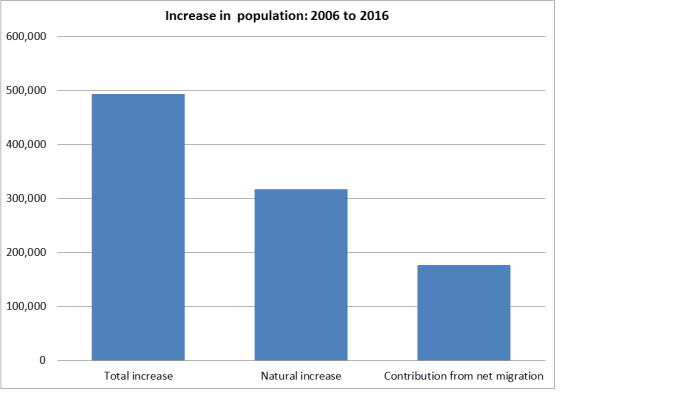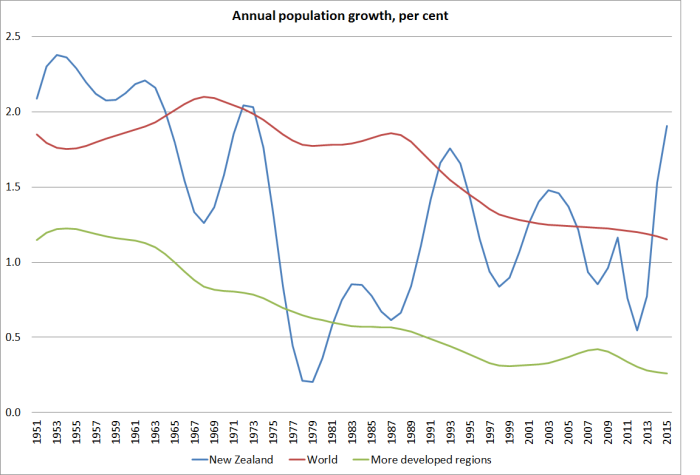New Zealand’s population is estimated to have risen by 11.8 per cent in the last decade (much of it in the last three years). The starting point for that estimate is reasonably well-anchored: I used the population numbers for the March quarter of 2006, and the 2006 Census happened in that month. The end-point (March 2016) is only an SNZ estimate, which will be recalibrated after the next census. But for now it is what we have.
Here is the high-level breakdown of where the population growth came from.

Net migration accounts for about 35 per cent of the total increase.
But even at very high level, this chart somewhat misrepresents the picture. Many migrants are of child-bearing age, and some of the natural increase will itself have resulted from the net migration flows of New Zealanders and foreigners (both those during this period, and those from earlier periods).
I’ve found it useful to think about the contribution of immigration policy to New Zealand’s population. At the extreme, almost the entire non-Maori population of New Zealand ultimately exists as a result of post-1840 immigration policy.
But even over more recent periods, one can distinguish – at least conceptually – between the choices of New Zealand citizens to come and go (mostly go), and those of foreign citizens. The choices of New Zealanders aren’t a matter of immigration policy at all. We shouldn’t, and don’t, try to impede those flows. By contrast, any foreign citizen living here requires the explicit permission of the New Zealand government. Some will be permanent residents, others will have work visas, and some will be students.
Statistics New Zealand has data on permanent and long-term migration flows by citizenship. But, as I’ve noted before, it is only indicative. People change their minds and their plans. New Zealanders planning to leave for a few months end up staying away for decades, and vice versa. And the same happens for foreigners coming here – some came intending to stay forever, but it just doesn’t work out and they leave. Others come thinking it might just be something short-term, and they end up getting permission to stay longer.
Over the last decade, these statistics show a net 233000 New Zealand citizens leaving, and a net 440000 foreign citizens arriving. That inflow of foreign citizens is equal to 89 per cent of the increase in the total population over that decade.
Actually, the contribution of non-citizen migration (the policy-controlled bit) might not be quite that large. The net migration inflow in the chart above is 177000 people over the decade, and the gap between the citizen and non-citizen net PLT data over the same period is 207000 people. We know the natural increase, and we have a reasonable fix on the population. So maybe somewhat fewer New Zealanders actually stayed away than said they were intending too, and perhaps some of the non-citizens who intended to stay went home. My hunch – no more – is that over this period more of the mismeasurement is around the NZ citizen flow (the Australian labour market has been tougher than most expected). But if the mismeasurement is split evenly between the NZ citizen and foreign citizen data, the direct contribution of immigration policy to population growth over this period would still be around 85 per cent. And the contribution to the birth rate of those non-citizen migrants is on top of that.
Then again, according to the arrival and departure cards, a net 228000 more people arrived in New Zealand in total than left between March 2006 and March 2016. That is rather more than the 177000 net migrants implicit in the SNZ population estimates. So perhaps we’ll find that the population has been growing even faster than SNZ thinks. If so, the contribution of immigration policy might drop back to around 80 per cent over the decade.
There is plenty of imprecision in all of this. But what is fairly clear is that (a) New Zealand’s population has been growing much faster than the population of most OECD countries, and (b) that the overwhelming bulk of that growth is resulting from immigration policy choices (the scale of the influx of non-citizens). Reasonable people can differ on the economic implications of those high rates of non-citizen immigration, but that the population would not have been growing rapidly at all without our unusually large non-citizen immigration programme shouldn’t really be in question.
Internationally, there is a variety of experiences of course. Among advanced countries, one has relatively successful countries with sharply falling populations (Latvia and Lithuania are down more than 20 per cent in the last 25 years) and sharply rising populations (Singapore’s population is up over 80 per cent in that period), and both good and mediocre performers with quite rapid population growth (New Zealand and Australian population growth rates have been similar over 25 years, and Israel has also had about 80 per cent population growth and a productivity performance about as disappointing as New Zealand’s. Population changes, even those directly associated with immigration, can be a response to domestic opportunities or available foreign ones. In some circumstances they might help strengthen per capita growth, and in other cases they might impede. One needs to take a country by country approach.
Taking a longer view, this chart is one I’ve used before. It compares New Zealand’s population growth rate with those of advanced countries and the world as a whole (using UN data).

Typically, our population growth rate has far-outstripped those of the advanced countries as a whole. The exception was the period I referred to in my post on Saturday, between the mid 1970s and the late 1980s, when the large net outflow of New Zealanders was already well-established, but immigration policy was not aggressively pursuing a large inflow of foreign citizens, unlike the situation in the decades before and since.